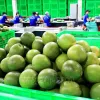Industrial production index rises 8.5% in seven months

The office reported that the IIP rose in 60 provinces and centrally-run cities and declined in only three others, mostly due to performance of the manufacturing-processing and power production and distribution sectors.
In the January-July period, the manufacturing-processing sector enjoyed a rise of 9.5%, contributing 8.2 percentage points to the overall IIP growth, while the electricity production and distribution industry recorded an increase of 12.4%, contributing 1.1 percentage points to the IIP rise.
The highest increase was seen in the production of rubber and plastic, with 28.7%, followed by beds, cabinets, tables and chairs production with 21.5%, and chemicals and chemical products production with 17.3%, and mining of metal ores, 15%.
Meanwhile, industries suffering reduction included crude oil and natural gas exploitation with 12.4%, repair, maintenance and installation of machinery and equipment, 2.9%, and production of other non-metallic mineral products, 1.8%.
Thanks to the stability of FDI capital inflows, the manufacturing and processing industry has accelerated, leading to the recovery of the accompanying utility sectors such as electricity distribution, water supply and waste treatment. The IIP has increased in a monthly and quarterly basis.
However, Pham Tuan Anh, Deputy Director of the Department of Industry under the Ministry of Industry and Trade (MoIT), said that despite good results in the first seven months of this year, industrial production has still faced many challenges.
Production still depends heavily on external factors, especially on the FDI sector. In addition, the added value of domestic industries is still low, while supporting industries are underdeveloped with few high-tech industrial products, Anh explained.
The GSO recommended the MoIT to continue promoting the transition of the industrial sector towards increased contributions manufacturing-processing industry and reduced proportion of machining and assembling of industrial products manufactured in Vietnam, while removing difficulties for businesses and building technical barriers for imported products.
Tags:





